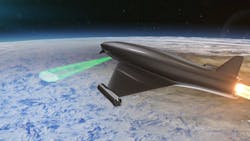The Laser Developed Atmospheric Lens (LDAL) system is a form of defense against directed-energy weapons. (Courtesy of BAE Systems)
Energy has long been used on the battlefield for communications and to track targets (in the form of radar systems), but energy may also be used as a weapon against hostile forces. Among a number of companies working on directed-energy weapons, such as high-power lasers, at least one is exploring defensive measures against these energy weapons. BAE Systems is working on a directed energy laser and lens system called a Laser Developed Atmospheric Lens (LDAL), which could be used to protect friendly troops, aircraft, ships, and land vehicles from attacks from high-power laser weapons.
The LDAL system mimics naturally occurring phenomena to temporarily alter the atmosphere into lens-like structures capable of redirecting electromagnetic (EM) energy, including light beams and radio waves. Two of the natural effects that are the basis for the LDAL system are the mirages that occur in deserts, caused by the bending of light in the hot atmosphere, and the reflective properties of the ionosphere, which has been known to reflect EM waves thousands of miles from radio stations.
The LDAL system uses a high-power pulsed laser to heat a small region of the atmosphere, to ionize that part of the atmosphere to create reflective effects. As Professor Nick Colosimo, BAE Systems’ futurist and technologist, notes: “Working with some of the best scientific minds in the UK, we’re able to incorporate emerging and disruptive technologies and evolve the landscape of potential military technologies in ways that, five or 10 years ago, many would never have dreamed possible.”


